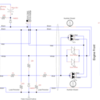I'm working up the courage to replace some of the incandescent bulbs in my engines which I have upgrades to TMCC with boards from ERR. I've watched several videos on you tube, but I'm still concerned I'll fry a board or mess something up and render the engine useless. I am planning to buy 3mm and 5mm LEDs with a positive rating of 20ma. I'm assuming the ERR board terminal for lights is 12 volts DC. According to a table on the page of the led calculator the voltage drop is between 3.0 and 3.5. The results calculator results is showing I need to insert a 430 ohm resistor in the circuit.
If someone would confirm the above and or correct the items which are wrong, I would appreciate it. Please remember I'm taking baby steps here, so please try to keep your responses as simple as possible.










